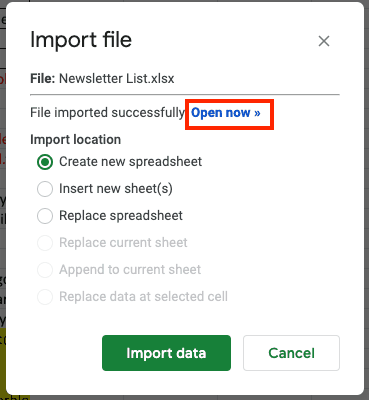

CSV format such as renaming column headers or adding additional columns. Changes done in ne window will be automatically reflected on the other window. Since its just another view of the same file, no one will ask you to save (you have another window still open). You can make changes in one window and Close it.
#Spreadsheet converter opens in new window windows#
There are numerous other features you can employ when converting data from. You can switch between the 2 windows (displaying different sheets) by using the shortcut CTRL + F6. This gets added during the conversion process to let you know that all rows were successfully converted to the new format. If you want to create a whole new workbook using existing data that is in a different file format, select File > Open and see if Excel can convert. You will also want to remove the number of affected rows at the end of the data set. The final step is to clean up any empty rows or aggregate data from the spreadsheet.

Once done, click Close & Load at the top left on the menu to import the data into a new worksheet. Click the grid icon in the top-left corner of the data grid and then select Use First Row as Headers (assuming the first row contains column names).

Click the Edit button at the bottom of the screen.Ī new window will appear with option to edit the data prior to import.

This will be the same file you currently have open.Īn import window will be displayed showing the data from the. CSV file to your computer and then open it.ģ) Select the Data tab from the menu ribbon and then click From Text/CSV.Ī window will appear which will allow you to select the file. The steps outlined below will guild you through the process of converting a. Often times these can be difficult to read and need to be converted to something more legible, such as a standard Excel. The most common scenario I see is data coming over as a comma delimited. However, there may be times where you are getting data from an outside source where you have limited control over the format of the file. Many programs such as LibreOffice expect carriage return, newline.These days you can generally export any file format you need from systems such as SQL Server Reporting Services or even directly from a SQL Server Agent Job. Any change you make to the workbook in one window will be reflected in the other. Keep in mind that you are NOT creating a duplicate file, just a new window to look at the same file. This can lead to ambiguities.Īnother ambiguity is whether records are separated by newline as would be typical for lines on UNIX, or carriage return, newline as would be typical for Microsoft platforms. The new window will have a dash and the number 2 (then 3, 4, 5 and so on as you continue to open new windows). If you closed the spreadsheet, open it again so that it is visible in Excel. to click on the diskette icon, hold down the Ctrl key and press S, or to select File > Save in the menu. A common convention is to perform the following escapes: \n for newline,Īnother common convention is to use the CSV convention from RFC 4180 and enclose these special characters in double quotes. Before you convert the spreadsheet to a web page, remember to save it in Excel. Since the values in the TSV format cannot contain literal tabs or new line characters, a convention is necessary for lossless conversion of text values with these characters. The TSV plain text above corresponds to the following tabular data:Ĭonventions for lossless conversion to TSV Sepal length Sepal width Petal length Petal width Species Before copying these Works spreadsheets to your new computer, save them in an Excel format (.xls or. Excel cannot open spreadsheets in the Works 4.x/2000 (.wks) format.


 0 kommentar(er)
0 kommentar(er)
